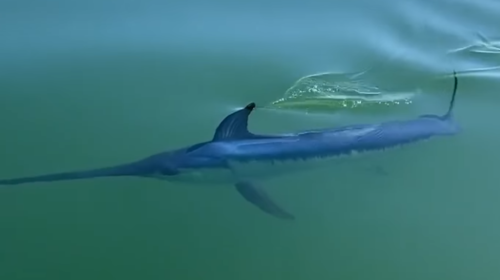
Swordfish
The Atlantic Bluefin Tuna (Thunnus thynnus) is a highly migratory, predatory fish renowned for its size, speed, and commercial value. It plays a crucial role in the marine ecosystem and is a prized catch in both commercial and recreational fishing.
9 15 years
Lifespan
455 cm
Length
Near Threatened
Conservation Status
100 km/h
Swimming speed
Carnivorous
Diet
Highly Migratory, Pelagic Migration
Migration
Appearance Overview
The Atlantic Bluefin Tuna is a large, torpedo-shaped fish with a metallic blue-black back and a silvery-white belly.
Coloration
Dark metallic blue on top, silvery-white underside
Fins
Two dorsal fins, the first depressible into a groove; small finlets behind second dorsal and anal fins
Body Shape
Torpedo-shaped, streamlined for speed
Keel
Strong lateral keel on the caudal peduncle
Length
Up to 13 feet (4 meters), commonly 6.5 feet (2 meters)
Weight
Up to 2,000 lbs (907 kg), commonly around 550 lbs (250 kg)
Diet
Carnivorous, feeding on a variety of fish (such as herring, mackerel, and hake), squid, and crustaceans.
Feeding Behavior
Highly active predator, using speed and agility to chase down prey. They often hunt cooperatively, herding and surrounding smaller fish.
Social Behavior
Forms large schools, particularly during migration and spawning. Shows complex social behaviors, including coordinated hunting.
Commercial Relevance
Extremely high value, especially in sushi and sashimi markets, where a single fish can fetch hundreds of thousands of dollars. It is also important in recreational fisheries.
Conservation measures
Subject to strict fishing quotas and regulations by international bodies like ICCAT. Measures include minimum size limits, seasonal closures, and monitoring programs.
Status
Endangered (IUCN)
Threats
Overfishing is the primary threat, driven by high demand in the sushi market. Other threats include bycatch in other fisheries and habitat degradation.
Habitat Distribution
Depth Range
0-1,000 meters (0-3,280 feet), typically in the upper layers of the ocean.
Geographic Range
Found in the Atlantic Ocean, Mediterranean Sea, and formerly in the Black Sea. They are divided into western and eastern populations.
Preferred Environment
Prefers temperate and subtropical waters; highly migratory, traversing both coastal and open ocean environments.
Reproduction and Life Cycle
Breeding Habits
Spawns in warm waters, primarily in the Mediterranean Sea and the Gulf of Mexico. Spawning occurs in large aggregations.
Development Stages
Eggs hatch into larvae that drift with the currents. Juveniles grow rapidly, feeding on plankton and small fish. They undergo significant physiological changes as they mature.
Fecundity
Females are highly fecund, capable of releasing up to 30 million eggs per spawning season.
Maturity Age
Reaches sexual maturity at around 4-8 years in the western Atlantic and 3-5 years in the eastern Atlantic and Mediterranean.
Faqs about Swordfish
How far do Bluefin Tuna migrate?
Atlantic Bluefin Tuna are highly migratory, capable of traveling thousands of miles across entire oceans.
How long do Bluefin Tuna live?
They can live up to 40 years, although this is rare due to fishing pressure.
Is it safe to eat Bluefin Tuna?
Yes, but it is heavily regulated, and consumers should ensure they are purchasing from sustainable and legal sources.
Are Bluefin Tuna warm-blooded?
Bluefin Tuna are warm-blooded, unlike most fish, which allows them to maintain a higher body temperature than the surrounding water.
How fast can Bluefin Tuna swim?
They can swim at speeds up to 43 mph (70 km/h) in short bursts.
Can Bluefin Tuna be farmed?
Farming Bluefin Tuna is challenging due to their size, migratory nature, and specific dietary needs, but some aquaculture operations exist.
What organization regulates Bluefin Tuna fishing?
ICCAT (International Commission for the Conservation of Atlantic Tunas) is the primary regulatory body.
Copyright @ Nature Style Limited. All Rights Reserved.
 English
English